The NVIDIA GeForce GTX 970 Review: Featuring EVGA
by Ryan Smith on September 26, 2014 10:00 AM ESTCompute
With GTX 980 NVIDIA surprised us with their stunning turnaround in in GPU compute performance, which saw them capable of reaching the top in many compute benchmarks they couldn’t before. GTX 970 meanwhile should benefit from these architectural and driver improvements, though since compute is nearly analogous to shader performance this is also a case where the performance difference between the GTX 970 and GTX 980 stands to be among its widest.
As always we’ll start with LuxMark2.0, the official benchmark of SmallLuxGPU 2.0. SmallLuxGPU is an OpenCL accelerated ray tracer that is part of the larger LuxRender suite. Ray tracing has become a stronghold for GPUs in recent years as ray tracing maps well to GPU pipelines, allowing artists to render scenes much more quickly than with CPUs alone

Thanks to GTX 980 taking the top spot here, GTX 970 still maintains a small lead over R9 290XU. So even with the GTX 970's weaker performance, it can still manage to outperform AMD's flagship in this case.
For our second set of compute benchmarks we have CompuBench 1.5, the successor to CLBenchmark. We’re not due for a benchmark suite refresh until the end of the year, however as CLBenchmark does not know what to make of GTX 980 and is rather old overall, we’ve upgraded to CompBench 1.5 for this review.
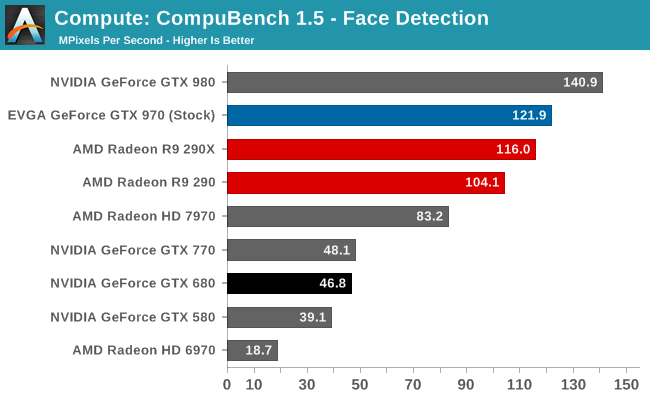
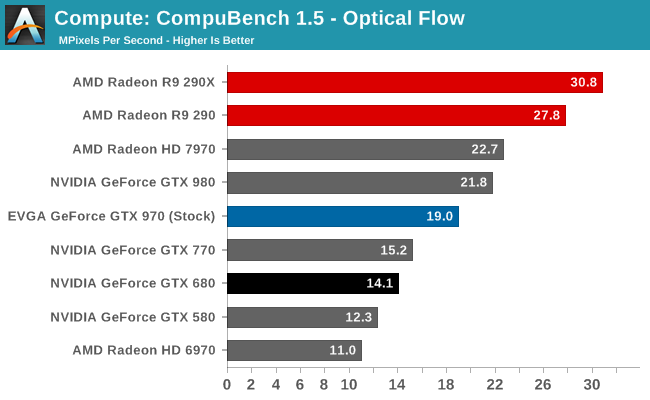
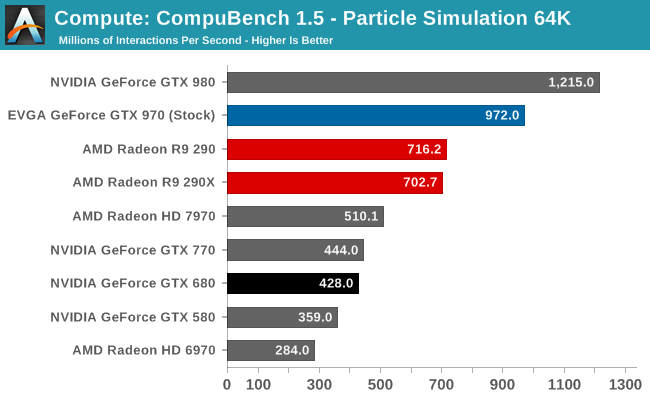
In the cases where the GTX 980 does well, so does the GTX 970. In the cases where the GTX 980 wasn’t fast enough to top the charts, the GTX 970 will be similarly close behind. Overall compared to AMD’s lineup we see the whole gamut, from a tie between the GTX 970 and R9 290XU to victories for either card.
Our 3rd compute benchmark is Sony Vegas Pro 12, an OpenGL and OpenCL video editing and authoring package. Vegas can use GPUs in a few different ways, the primary uses being to accelerate the video effects and compositing process itself, and in the video encoding step. With video encoding being increasingly offloaded to dedicated DSPs these days we’re focusing on the editing and compositing process, rendering to a low CPU overhead format (XDCAM EX). This specific test comes from Sony, and measures how long it takes to render a video.
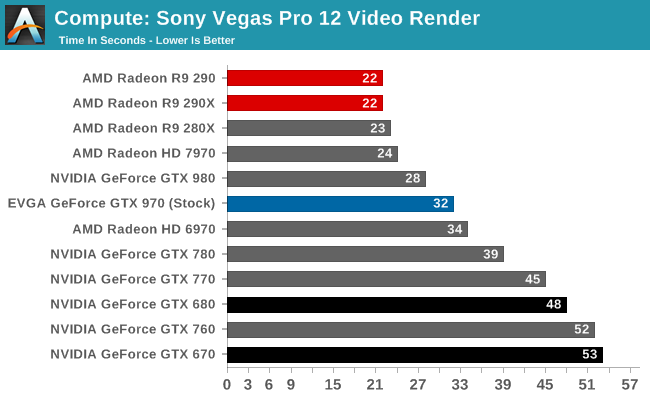
As expected, GTX 970 sheds a bit of performance here. AMD still holds a lead here overall, and against GTX 970 that lead is a little bit larger.
Moving on, our 4th compute benchmark is FAHBench, the official Folding @ Home benchmark. Folding @ Home is the popular Stanford-backed research and distributed computing initiative that has work distributed to millions of volunteer computers over the internet, each of which is responsible for a tiny slice of a protein folding simulation. FAHBench can test both single precision and double precision floating point performance, with single precision being the most useful metric for most consumer cards due to their low double precision performance. Each precision has two modes, explicit and implicit, the difference being whether water atoms are included in the simulation, which adds quite a bit of work and overhead. This is another OpenCL test, utilizing the OpenCL path for FAHCore 17.
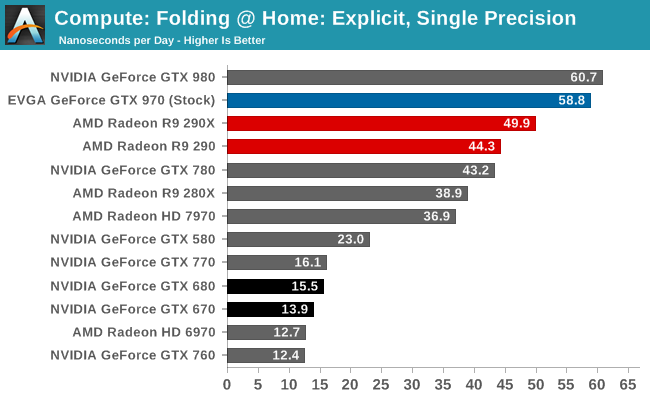
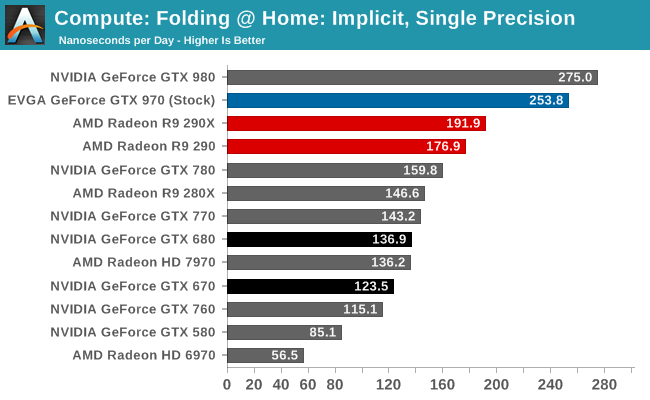
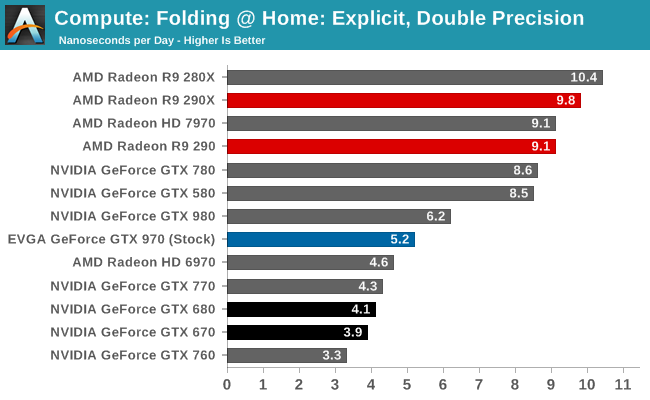
With the GTX 980 holding such a commanding lead here, even with the GTX 970’s lower performance it still is more than enough to easily beat any other card in single precision Folding @ Home workloads. Only in double precision with NVIDIA’s anemic 1:32 ratio does GTX 970 falter.
Wrapping things up, our final compute benchmark is an in-house project developed by our very own Dr. Ian Cutress. SystemCompute is our first C++ AMP benchmark, utilizing Microsoft’s simple C++ extensions to allow the easy use of GPU computing in C++ programs. SystemCompute in turn is a collection of benchmarks for several different fundamental compute algorithms, with the final score represented in points. DirectCompute is the compute backend for C++ AMP on Windows, so this forms our other DirectCompute test.

Recently this has been a stronger benchmark for AMD cards than NVIDIA cards, and consequently GTX 970 doesn’t enjoy quite the lead it sees elsewhere. Though not too far behind R9 280X and even R9 290, like GTX 980 it can’t crunch numbers quite fast enough to keep up with R9 290XU.










155 Comments
View All Comments
wetwareinterface - Saturday, September 27, 2014 - link
they did it because they have customers with at most one dp monitor and if using multiple monitors most have dvi still. also they have all these connectors they bought up laying around so....Gigaplex - Monday, September 29, 2014 - link
It's trivial to convert from DP to DVI but not the other way around.Mr Perfect - Monday, September 29, 2014 - link
Hmm, it has a blower too. It looks like their own design though, I wonder if it matches the 980's blower in noise and cooling.ggathagan - Friday, September 26, 2014 - link
Gigabyte's version has the same I/O setup as the 980Mr Perfect - Monday, September 29, 2014 - link
Good find. That one's an option then.HanzNFranzen - Friday, September 26, 2014 - link
Well, it was quite a run for me and AMD. I was a GeForce user back in the day with the Geforce 2 and then the Ti 4600. In 2002 I switched up to AMD when they released the 9700 Pro and never looked back. I have been waiting and waiting for the R9 cards to drop in price to go into my new X99 build. I waited for these 900 cards thinking the response would be somewhat quick as far as an announcement for a competing Radeon or at least a price drop for the 290X. But it never came. (Except that the 390 may be factory water cooled.... which was an "uh oh.." in my mind as far as heat and power is concerned). So 12 years later, I am now back to NVidia as I just ordered my GTX 980 yesterday. I think that NVidia finally released a card at a price and power consumption that just cannot be ignored. A truly impressive feat they have pulled off with the Maxwell line, and I have chosen to reward that effort with my business. Who knows, MaxWELL in a HasWELL-e build... perhaps fate was involved? It is to be named my Wellness system =P Will be quite an upgrade from a i7 920 and 6950. I can't wait to get it assembled!! And by the way, thanks for the 2 great reviews Ryan!wetwareinterface - Saturday, September 27, 2014 - link
i'm curious why you'd spend all that money on a cpu ram motherboard config and then get a gaming card. you could have saved a ton of money and bought 4790, msi gaming series board ddr3 ram and bought 2 980's if gaming is your focus youd have the faster gaming cpu and graphics card setup that way.HanzNFranzen - Saturday, September 27, 2014 - link
I would agree if I were a 'tick tock' cadence upgrader, and if gaming were my only focus. I weighed going 4790 for a few months. But coming off of a X58 build that I've owned for 6 years it may be possible that this build stays with me just as long, and I believe a 6 core will be the better option than a 4 core in the long run. As far as a gaming card, this is a desktop build not a workstation.asgallant - Friday, September 26, 2014 - link
Color me intrigued by the 970. I'm considering a pair of these in SLI for 4k gaming (as other reviews indicate they scale quite well), but I'm running a Sandy-Bridge era rig, with x8/x8 PCIe 2 as the only SLI option, and would like to know if I'd run into a PCIe bandwidth bottleneck on these cards. Any chance of a quick scaling test making it into the (assumed to be coming) SLI review?boozed - Friday, September 26, 2014 - link
Improvements in performance and efficiency have finally progressed to the point that it makes sense to upgrade that four year old system. Wow.